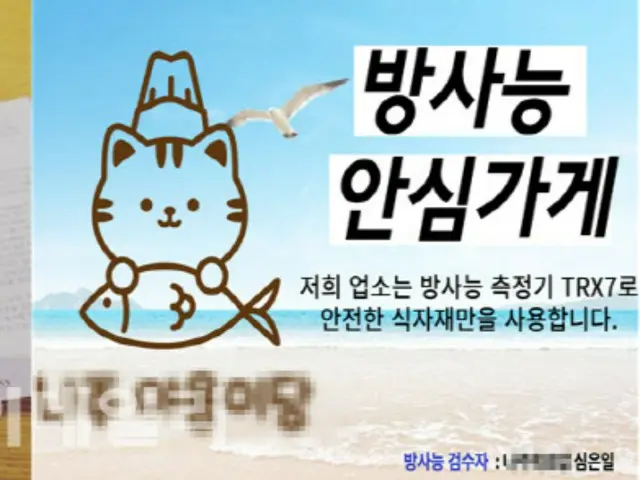Eight years in Naju City, Jeollanam-do, South Korea
Shim Eun-il (40), who runs a sushi restaurant, decided to put up a recently created ``Radiation Safe Store'' mark at the entrance of her restaurant starting on the 29th. Discharge of treated water from nuclear power plants in Japan sparked controversy
Since then, he has purchased a radioactivity meter that costs around 100,000 won and is testing the fish he uses for sushi, but he feels like that alone is not enough. He even told a colleague who runs a nearby sashimi restaurant,
I told you that I plan to encourage you to attach a mark. He added, ``If the government says it's really safe, people will believe it, but if it responds easily, it will only double the sense of anxiety.'' He added, ``The opposition parties also claim that it's unsafe and dangerous.''
If so, I would like you to confirm the radioactivity and show me the evidence." After the discharge of treated water into the ocean has begun in earnest, workers in the fisheries industry are scrambling to find ways to help themselves. Not only the Japanese government but also the Korean government
Although the prefectural government continues to claim that the product is ``scientifically safe,'' consumers still remain anxious, and in the end, merchants suffer the consequences.
It is said that the number of people purchasing radiation measuring instruments has increased significantly recently. A sales representative said, ``Recently, I made a purchase.
"The number of people making inquiries has increased," he said, adding, "There are some devices that cost hundreds of thousands of won, but it seems like consumers who are worried about them are looking for them." In fact, according to the portal site NAVER, radiation
The amount of searches for performance measurement devices has increased more than 33 times since a month ago. In addition to Mr. Shim, there are many other merchants who purchase radiation measuring instruments. Fusion Japanese cuisine in Gangseo-gu, Seoul
Mr. A, who runs the store, said he purchased a radiation measuring device earlier this year. He said, ``In order for consumers who are concerned about radioactive contamination to eat food with a little peace of mind, we purchased a measuring device and
We check the numbers three times each time." Mr. A, the operator of a sushi restaurant who purchased a measuring device for 100,000 won, said, ``All I can do is check the measuring device every day,'' and ``I believe in the ingredients.''
If we don't get discouraged, it will be difficult for us to continue operating in the future." Radioactivity measuring instruments are used not only by merchants but also by general consumers. Anne (43), a full-time housewife, already earned 230,000 yen in July.
I bought a radioactivity measuring instrument for Won. Ahn said he used the radioactivity detector about four times at the seafood market. She said, "The natural radiation dose is about 0.1 to 0.3 microsieverts per hour.
``We measured crabs at the market, and luckily, 0.22 microsieverts came out, which gave us peace of mind when cooking.'' However, low-cost portable radiation meters do not provide accurate radioactive contamination levels.
It has been pointed out that the measured values cannot be expected. Portable radiation meters alone cannot determine whether cesium and iodine in food and drink meet acceptable standards.
In other words, we have to use an expensive nuclide analyzer that can accurately measure the concentration. Since various factors such as the measurement environment and method, and the user's skill level act in a complex manner,
Experts advise avoiding excessive reliance on self-test results alone. Another person involved in radiation safety management said, "Because there is radioactivity in the air, we simply measured it.
You can't judge just by the 'beep' sound of the vessel."
2023/08/30 09:43 KST
Copyrights(C) Edaily wowkorea.jp 88

